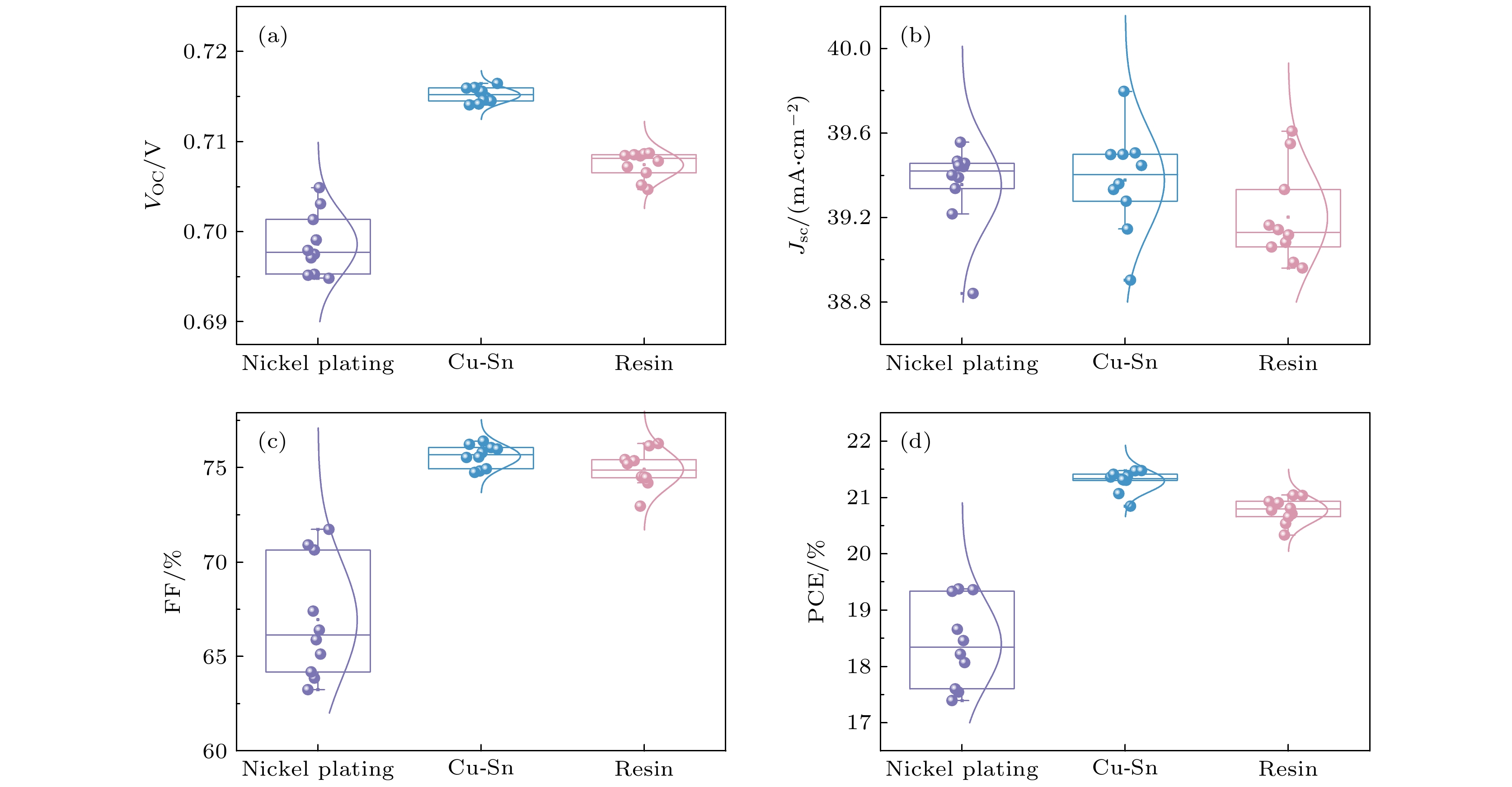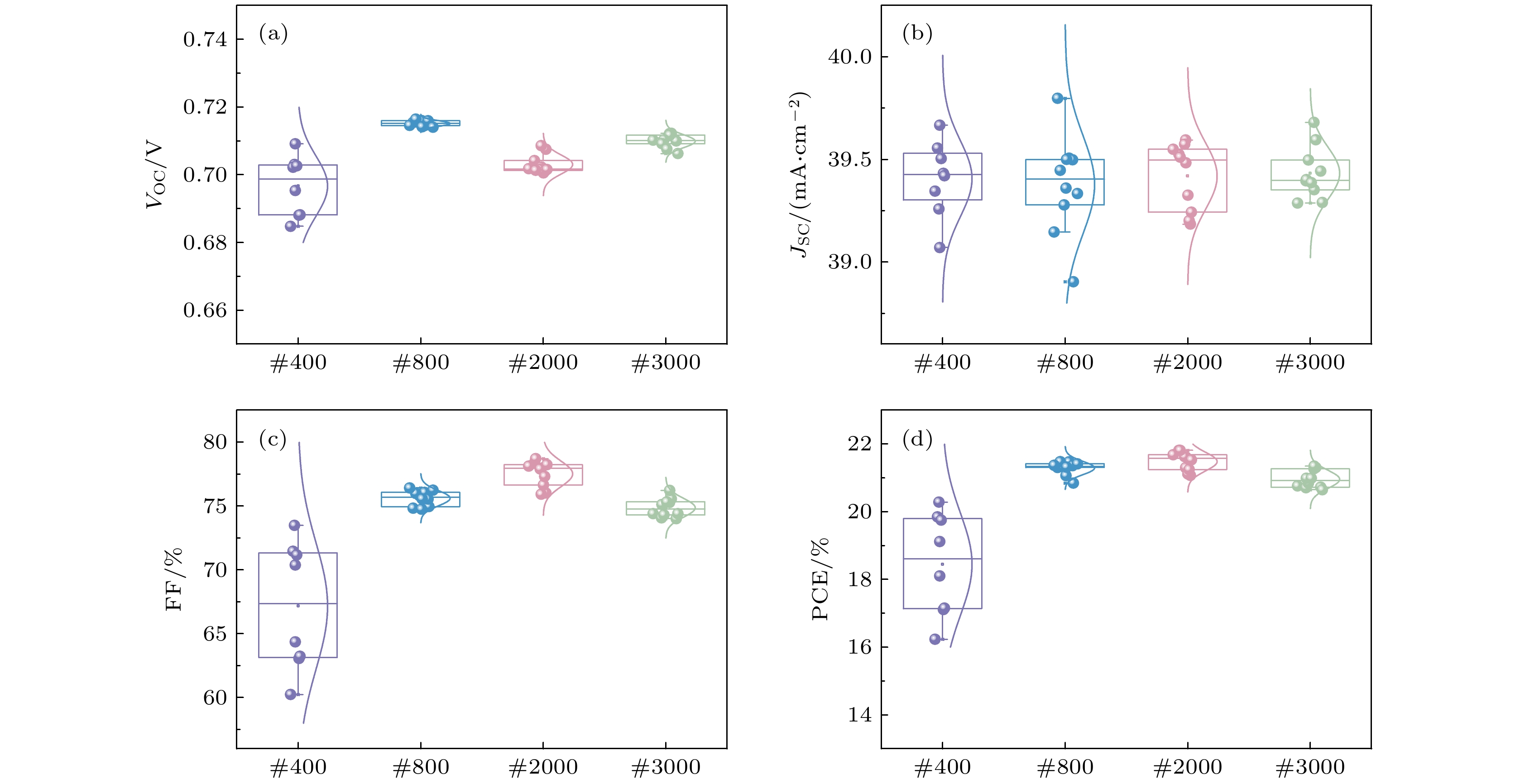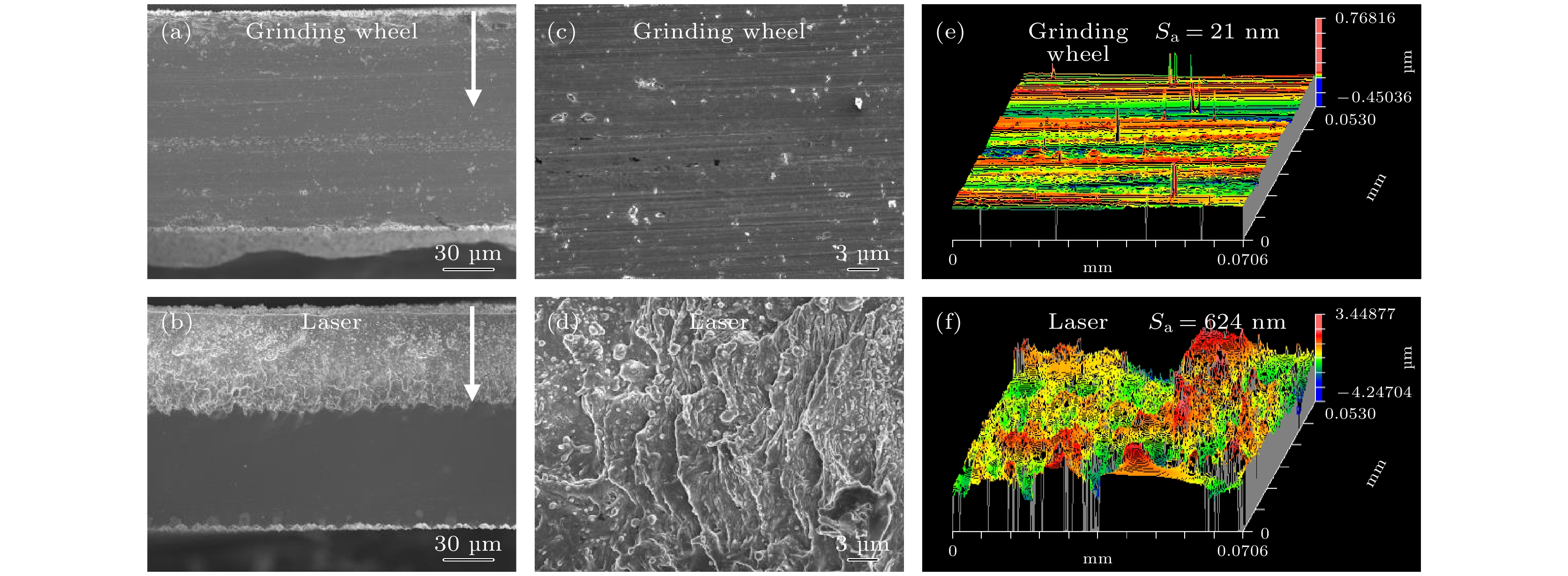-
Although the commercial application of solar cells pursues scalable and large-area devices, small-area solar cells on a scale of several centimeters possess many advantages such as low fabrication cost and facile high-throughput screening in the research laboratory. Most emerging photovoltaic technology starts from the studying of small-area devices. Recently, perovskite/silicon tandem solar cells have aroused extensive research interest because they can break through the radiative efficiency limit of single-junction solar cells. However, when commercial large-area silicon cells are cut into small pieces with a few squared centimeters in area for laboratory use, there occurs a significant efficiency loss, limiting the performance of tandem cells. Herein, to eliminate the thermal damage caused by the traditional laser cutting method and also reduce the non-radiative recombination of heterojunction silicon cells after being cut, a cold-manufacturing method of grinding wheel dicing is used to cut heterojunction silicon cells. This method is realized by high-speed mechanical grinding accompanied by liquid washing, which avoids damaging the edge of solar cell caused by heat. Compared with the device cut by laser, the heterojunction silicon cells cut by the cold-manufacturing method exhibit less cross-sectional damage. The measurements by scanning electron microscopy (SEM) and three-dimensional optical profilometer reveal that the morphology of the device edge is smoother than the counterpart cut by laser. Device physics measurements including electrochemical impedance spectrum(EIS), dark current-voltage curves, transient photovoltage (TPV), transient photocurrent (TPC), and the dependence of short-circuit current density and open-circuit voltage on light intensity reveal that the cold-manufacturing method can significantly prevent the heterojunction silicon cells from non-radiatively recombining after being cut. These results indicate that the edge-recombination of the silicon solar cells cut by grinding wheels is reduced compared with that cut by laser. As a result, statistical analysis of the device performance reveals that both the open-circuit voltage and fill factor of the device are improved, and the average photoelectric conversion efficiency increases by an absolute efficiency of ~1%. Stacking the obtained silicon cells with the normal transparent perovskite solar cells, the obtained four-terminal perovskite/silicon tandem solar cells deliver an efficiency of over 28%. This work emphasizes the importance of reducing efficiency loss during manufacturing the heterojunction silicon solar cell in fabricating high-performance silicon-based tandem solar cells.
-
Keywords:
- silicon cell cutting /
- edge recombination /
- heterojunction silicon cell /
- perovskite/silicon tandem solar cells
[1] Binetti S, Acciarri M, Le Donne A, Morgano M, Jestin Y 2013 Int. J. Photoenergy 2013 249502
 Google Scholar
Google Scholar
[2] Yoshikawa K, Kawasaki H, Yoshida W, Irie T, Konishi K, Nakano K, Uto T, Adachi D, Kanematsu M, Uzu H, Yamamoto K 2017 Nat. Energy 2 17032
 Google Scholar
Google Scholar
[3] Andreani L C, Bozzola A, Kowalczewski P, Liscidini M, Redorici L 2019 Adv. Phys. X. 4 1548305
 Google Scholar
Google Scholar
[4] Kojima A, Teshima K, Shirai Y, Miyasaka T 2009 J. Am. Chem. Soc. 131 6050
 Google Scholar
Google Scholar
[5] Lee M M, Teuscher J, Miyasaka T, Murakami T N, Snaith H J 2012 Science 338 643
 Google Scholar
Google Scholar
[6] Yang W S, Noh J H, Jeon N J, Kim Y C, Ryu S, Seo J, Seok S I 2015 Science 348 1234
 Google Scholar
Google Scholar
[7] Jiang Q, Zhao Y, Zhang X, Yang X, Chen Y, Chu Z, Ye Q, Li X, Yin Z, You J 2019 Nat. Photonics 13 460
 Google Scholar
Google Scholar
[8] National Renewable Energy Laboratory 2022 Research Cell Efficienc Recordshttps://www.nrel.gov/pv/cell-efficiency.html (accessed December, 2022)
[9] Wang R, Huang T, Xue J, Tong J, Zhu K, Yang Y 2021 Nat. Photonics 15 411
 Google Scholar
Google Scholar
[10] Polman A, Knight M, Garnett E C, Ehrler B, Sinke W C 2016 Science 352 aad4424
 Google Scholar
Google Scholar
[11] Jošt M, Kegelmann L, Korte L, Albrecht S 2020 Adv. Energy Mater. 10 1904102
 Google Scholar
Google Scholar
[12] Liu N, Wang L, Xu F, Wu J, Song T, Chen Q 2020 Front. Chem. 8 603375
 Google Scholar
Google Scholar
[13] Aydin E, Allen T G, De Bastiani M, Xu L, Ávila J, Salvador M, Van Kerschaver E, De Wolf S 2020 Nat. Energy 5 851
 Google Scholar
Google Scholar
[14] Fu F, Li J, Yang T C-J, Liang H, Faes A, Jeangros Q, Ballif C, Hou Y 2022 Adv. Mater. 34 2106540
 Google Scholar
Google Scholar
[15] Coletti G, Luxembourg S L, Geerligs L J, et al. 2020 ACS Energy Lett. 5 1676
 Google Scholar
Google Scholar
[16] Kothandaraman R K, Jiang Y, Feurer T, Tiwari A N, Fu F 2020 Small Methods 4 2000395
 Google Scholar
Google Scholar
[17] Leijtens T, Bush K A, Prasanna R, McGehee M D 2018 Nat. Energy 3 828
 Google Scholar
Google Scholar
[18] Kim C U, Jung E D, Noh Y W, Seo S K, Choi Y, Park H, Song M H, Choi K J 2021 EcoMat 3 e12084
 Google Scholar
Google Scholar
[19] Chen C, Song Z, Xiao C, Awni R A, Yao C, Shrestha N, Li C, Bista S S, Zhang Y, Chen L, Ellingson R J, Jiang C-S, Al-Jassim M, Fang G, Yan Y 2020 ACS Energy Lett. 5 2560
 Google Scholar
Google Scholar
[20] Wang D, Guo H, Wu X, Deng X, Li F, Li Z, Lin F, Zhu Z, Zhang Y, Xu B, Jen A K-Y 2022 Adv. Funct. Mater. 32 2107359
 Google Scholar
Google Scholar
[21] Chen B, Baek S-W, Hou Y, Aydin E, et al. 2020 Nat. Commun. 11 1257
 Google Scholar
Google Scholar
[22] Ying Z, Yang X, Zheng J, Zhu Y, Xiu J, Chen W, Shou C, Sheng J, Zeng Y, Yan B, Pan H, Ye J, He Z 2021 J. Mater. Chem. A 9 12009
 Google Scholar
Google Scholar
[23] Wang Z, Zhu X, Zuo S, Chen M, Zhang C, Wang C, Ren X, Yang Z, Liu Z, Xu X, Chang Q, Yang S, Meng F, Liu Z, Yuan N, Ding J, Liu S, Yang D 2020 Adv. Funct. Mater. 30 1908298
 Google Scholar
Google Scholar
[24] Tong J, Jiang Q, Zhang F, Kang S B, Kim D H, Zhu K 2020 ACS Energy Lett. 6 232
 Google Scholar
Google Scholar
[25] Anaya M, Lozano G, Calvo M E, Míguez H 2017 Joule 1 769
 Google Scholar
Google Scholar
[26] Chen B, Ren N, Li Y, Yan L, Mazumdar S, Zhao Y, Zhang X 2021 Adv. Energy Mater. 11 2100856
 Google Scholar
Google Scholar
[27] 王其, 延玲玲, 陈兵兵, 李仁杰, 王三龙, 王鹏阳, 黄茜, 许盛之, 侯国付, 陈新亮, 李跃龙, 丁毅, 张德坤, 王广才, 赵颖, 张晓丹 2021 70 057802
 Google Scholar
Google Scholar
Wang Q, Yan L L, Chen B B, Li R J, Wang S L, Wang P Y, Hang Q, Xu S Z, Hou G F, Chen X L, Li Y L, Ding Y, Zhang D K, Wang G C, Zhao Y, Zhang X D 2021 Acta Phys. Sin. 70 057802
 Google Scholar
Google Scholar
[28] Chen K C, Su Y K, Lin C L, Hsu H C 2011 J. Lightwave Technol. 29 1907
 Google Scholar
Google Scholar
[29] Rauscher P, Hauptmann J, Beyer E 2013 Phys. Procedia 41 312
 Google Scholar
Google Scholar
[30] Park J, Dao V A, Kim S, Pham D P, Kim S, Le A H T, Kang J, Yi J 2018 Sci. Rep. 8 15386
 Google Scholar
Google Scholar
[31] Li M, Chen J, Lin Q, Wu Y, Mu D 2019 Diam. Relat. Mater. 97 107440
 Google Scholar
Google Scholar
[32] Gurevich E L, Gurevich S V 2014 Appl. Surf. Sci. 302 118
 Google Scholar
Google Scholar
[33] He Z, Xiong J, Dai Q, Yang B, Zhang J, Xiao S 2020 Nanoscale 12 6767
 Google Scholar
Google Scholar
[34] Lian X, Chen J, Shan S, Wu G, Chen H 2020 ACS Appl. Mater. Interfaces 12 46340
 Google Scholar
Google Scholar
-
图 4 砂轮划片机切割与激光切割后HIT电池截面形貌和粗糙度对比 (a), (b)截面形貌; (c), (d)截面局部放大图; (e), (f)三维轮廓图
Figure 4. Comparison of cross-sectional SEM images and roughness of HIT silicon solar cell after grinding wheel and laser cutting: (a), (b) Cross-sectional morphology; (c), (d) partial magnification of cross-section morphology; (e), (f) 3 D outline of the cross-section.
图 5 切割后HIT电池的载流子复合动力学 (a) 在0.05 V偏压和黑暗条件下测得器件EIS; (b) 器件的暗态J-V曲线; (c) 瞬态光电压; (d) 瞬态光电流; (e) 短路电流密度与光强的关系; (f)开路电压与光强的关系
Figure 5. Charge recombination kinetics of silicon solar cells after cutting: (a) Electrochemical impedance spectra of devices measured in the dark at 0.05 V bias; (b) dark J-V curves of the devices; (c) TPV; (d) TPC; (e) relationship between JSC and light intensity; (f) relationship between VOC and light intensity.
图 6 (a) 4T-TSCs结构示意图; (b) ST-PSCs的截面SEM形貌; (c) 切割后HIT硅电池的J-V曲线; (d) 4T-TSCs的EQE曲线; (e) 4T-TSCs的J-V曲线
Figure 6. (a) Schematic diagram of the structure of 4T-TSCs; (b) cross-sectional SEM image of ST-PSC; (c) J-V curve of HIT silicon solar cell after cutting; (d) EQE curves of 4T-TSCs; (e) J-V curves of 4T-TSCs.
表 1 切割前与不同激光功率切割后对应HIT电池的最优性能
Table 1. Optimal performance of HIT silicon solar cell before and after cutting with different laser power.
Laser
powerVOC/V JSC/(mA·cm–2) FF/% PCE/% Before
cutting0.731 39.46 82.61 23.83 9 W 0.703 38.79 74.36 20.29 12 W 0.701 39.27 75.83 20.88 15 W 0.697 39.62 73.90 20.41 18 W 0.699 39.53 74.24 20.52 表 2 不同砂轮黏合剂所对应切割后HIT电池最优器件的性能
Table 2. Optimal performance of HIT silicon solar cell after cutting with different grinding wheel adhesives.
Adhesives JSC /(mA·cm–2) VOC /V FF/% PCE /% Nickel plating 39.45 0.695 70.64 19.37 Cu-Sn 39.47 0.716 75.98 21.47 resin 38.98 0.709 76.15 21.04 表 3 Cu-Sn刀具中金刚石磨粒的粒度对应切割后HIT电池最优器件的性能
Table 3. The influence of the size of diamond abrasive in Cu-Sn cutter on the performance of HIT silicon solar cells after cutting.
Particle size VOC/V JSC /(mA·cm–2) FF/% PCE/% #400 0.703 39.23 73.48 20.28 #800 0.716 39.45 75.98 21.47 #2000 0.704 39.52 78.37 21.81 #3000 0.712 39.35 76.21 21.34 表 4 4 T-TSCs的详细J-V参数
Table 4. Detailed J-V parameters of 4 T-TSCs.
Device VOC/V JSC/
(mA·cm–2)FF/% PCE/% Silicon cell (filtered by
ST-PSC)0.680 16.87 79.04 9.08 ST-PSCs 1.207 20.22 78.81 19.25 4 T-TSCs 28.33 -
[1] Binetti S, Acciarri M, Le Donne A, Morgano M, Jestin Y 2013 Int. J. Photoenergy 2013 249502
 Google Scholar
Google Scholar
[2] Yoshikawa K, Kawasaki H, Yoshida W, Irie T, Konishi K, Nakano K, Uto T, Adachi D, Kanematsu M, Uzu H, Yamamoto K 2017 Nat. Energy 2 17032
 Google Scholar
Google Scholar
[3] Andreani L C, Bozzola A, Kowalczewski P, Liscidini M, Redorici L 2019 Adv. Phys. X. 4 1548305
 Google Scholar
Google Scholar
[4] Kojima A, Teshima K, Shirai Y, Miyasaka T 2009 J. Am. Chem. Soc. 131 6050
 Google Scholar
Google Scholar
[5] Lee M M, Teuscher J, Miyasaka T, Murakami T N, Snaith H J 2012 Science 338 643
 Google Scholar
Google Scholar
[6] Yang W S, Noh J H, Jeon N J, Kim Y C, Ryu S, Seo J, Seok S I 2015 Science 348 1234
 Google Scholar
Google Scholar
[7] Jiang Q, Zhao Y, Zhang X, Yang X, Chen Y, Chu Z, Ye Q, Li X, Yin Z, You J 2019 Nat. Photonics 13 460
 Google Scholar
Google Scholar
[8] National Renewable Energy Laboratory 2022 Research Cell Efficienc Recordshttps://www.nrel.gov/pv/cell-efficiency.html (accessed December, 2022)
[9] Wang R, Huang T, Xue J, Tong J, Zhu K, Yang Y 2021 Nat. Photonics 15 411
 Google Scholar
Google Scholar
[10] Polman A, Knight M, Garnett E C, Ehrler B, Sinke W C 2016 Science 352 aad4424
 Google Scholar
Google Scholar
[11] Jošt M, Kegelmann L, Korte L, Albrecht S 2020 Adv. Energy Mater. 10 1904102
 Google Scholar
Google Scholar
[12] Liu N, Wang L, Xu F, Wu J, Song T, Chen Q 2020 Front. Chem. 8 603375
 Google Scholar
Google Scholar
[13] Aydin E, Allen T G, De Bastiani M, Xu L, Ávila J, Salvador M, Van Kerschaver E, De Wolf S 2020 Nat. Energy 5 851
 Google Scholar
Google Scholar
[14] Fu F, Li J, Yang T C-J, Liang H, Faes A, Jeangros Q, Ballif C, Hou Y 2022 Adv. Mater. 34 2106540
 Google Scholar
Google Scholar
[15] Coletti G, Luxembourg S L, Geerligs L J, et al. 2020 ACS Energy Lett. 5 1676
 Google Scholar
Google Scholar
[16] Kothandaraman R K, Jiang Y, Feurer T, Tiwari A N, Fu F 2020 Small Methods 4 2000395
 Google Scholar
Google Scholar
[17] Leijtens T, Bush K A, Prasanna R, McGehee M D 2018 Nat. Energy 3 828
 Google Scholar
Google Scholar
[18] Kim C U, Jung E D, Noh Y W, Seo S K, Choi Y, Park H, Song M H, Choi K J 2021 EcoMat 3 e12084
 Google Scholar
Google Scholar
[19] Chen C, Song Z, Xiao C, Awni R A, Yao C, Shrestha N, Li C, Bista S S, Zhang Y, Chen L, Ellingson R J, Jiang C-S, Al-Jassim M, Fang G, Yan Y 2020 ACS Energy Lett. 5 2560
 Google Scholar
Google Scholar
[20] Wang D, Guo H, Wu X, Deng X, Li F, Li Z, Lin F, Zhu Z, Zhang Y, Xu B, Jen A K-Y 2022 Adv. Funct. Mater. 32 2107359
 Google Scholar
Google Scholar
[21] Chen B, Baek S-W, Hou Y, Aydin E, et al. 2020 Nat. Commun. 11 1257
 Google Scholar
Google Scholar
[22] Ying Z, Yang X, Zheng J, Zhu Y, Xiu J, Chen W, Shou C, Sheng J, Zeng Y, Yan B, Pan H, Ye J, He Z 2021 J. Mater. Chem. A 9 12009
 Google Scholar
Google Scholar
[23] Wang Z, Zhu X, Zuo S, Chen M, Zhang C, Wang C, Ren X, Yang Z, Liu Z, Xu X, Chang Q, Yang S, Meng F, Liu Z, Yuan N, Ding J, Liu S, Yang D 2020 Adv. Funct. Mater. 30 1908298
 Google Scholar
Google Scholar
[24] Tong J, Jiang Q, Zhang F, Kang S B, Kim D H, Zhu K 2020 ACS Energy Lett. 6 232
 Google Scholar
Google Scholar
[25] Anaya M, Lozano G, Calvo M E, Míguez H 2017 Joule 1 769
 Google Scholar
Google Scholar
[26] Chen B, Ren N, Li Y, Yan L, Mazumdar S, Zhao Y, Zhang X 2021 Adv. Energy Mater. 11 2100856
 Google Scholar
Google Scholar
[27] 王其, 延玲玲, 陈兵兵, 李仁杰, 王三龙, 王鹏阳, 黄茜, 许盛之, 侯国付, 陈新亮, 李跃龙, 丁毅, 张德坤, 王广才, 赵颖, 张晓丹 2021 70 057802
 Google Scholar
Google Scholar
Wang Q, Yan L L, Chen B B, Li R J, Wang S L, Wang P Y, Hang Q, Xu S Z, Hou G F, Chen X L, Li Y L, Ding Y, Zhang D K, Wang G C, Zhao Y, Zhang X D 2021 Acta Phys. Sin. 70 057802
 Google Scholar
Google Scholar
[28] Chen K C, Su Y K, Lin C L, Hsu H C 2011 J. Lightwave Technol. 29 1907
 Google Scholar
Google Scholar
[29] Rauscher P, Hauptmann J, Beyer E 2013 Phys. Procedia 41 312
 Google Scholar
Google Scholar
[30] Park J, Dao V A, Kim S, Pham D P, Kim S, Le A H T, Kang J, Yi J 2018 Sci. Rep. 8 15386
 Google Scholar
Google Scholar
[31] Li M, Chen J, Lin Q, Wu Y, Mu D 2019 Diam. Relat. Mater. 97 107440
 Google Scholar
Google Scholar
[32] Gurevich E L, Gurevich S V 2014 Appl. Surf. Sci. 302 118
 Google Scholar
Google Scholar
[33] He Z, Xiong J, Dai Q, Yang B, Zhang J, Xiao S 2020 Nanoscale 12 6767
 Google Scholar
Google Scholar
[34] Lian X, Chen J, Shan S, Wu G, Chen H 2020 ACS Appl. Mater. Interfaces 12 46340
 Google Scholar
Google Scholar
Catalog
Metrics
- Abstract views: 7063
- PDF Downloads: 175
- Cited By: 0















 DownLoad:
DownLoad:





